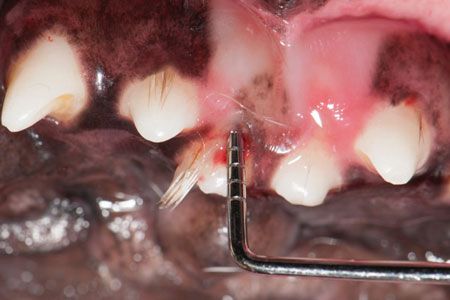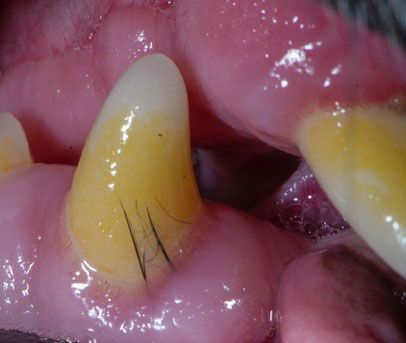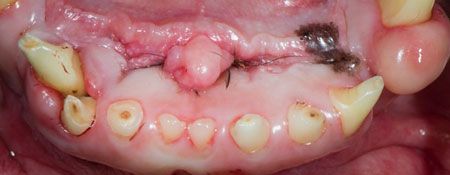Image Quiz: When a dog's teeth are a hairy problem
DEK Bulldogs, Labrador retrievers and beagles are prone to it. Why, what is it, and what can be done?
Let's start this one quick. Check out the pictures below. Guess your answer. Then dive into the details behind the mystery of these hairy mouths on the next page.



What's causing periodontal problems in these dogs?
a) Subgingival hair
b) Teratoma
c) Enamel defects?
d) Tooth crowding?
e) Epulis?
That's right: subgingival hair. That's the dog's own hair deposited under the gums.
Often during an oral examination in dogs with short, coarse coats (e.g., bulldogs, Labrador retrievers, beagles), you'll see coarse hairs extending from the skin. Diseases such as atopy, demodicosis or flea bite allergy can result in excessive self-grooming and hair deposited under the gums of the canines and incisors or even the hard palate gingiva. (This also confuses pet owners; a routine Google search turns up dozens of forum posts asking what the deal is with the hair in their bulldog's mouth!)
Unfortunately, gingival disease may occur secondary to a foreign body reaction to the trapped hair in the gingival sulci. Even though hair composed of the dog's own cells may appear to be innocently lying below the gingiva, it acts as an irritant in the gingival sulcus. Hair traps bacteria, provoking periodontal inflammation, infection, loss of tooth-supporting structures and pain.
There's no way to predetermine which dogs will react and which won't. And hair located anywhere other than on the skin can cause inflammation and infection. So once hair is noted subgingivally, it needs to be removed and the damage assessed.
Treatment
Hair removal from the rostral gingiva in the examination room usually can be accomplished easily with a cotton-tipped applicator. If inflammation or bleeding is present, further examination under anesthesia is indicated. Extracting teeth with stage 3 mobility or advanced periodontal disease can allow affected tissues to heal and not be further inflamed by coarse-hair foreign-body reaction.

The veterinarian, veterinary technician or client at home (with a calm dog) can use a long cotton-tipped applicator to remove excess hair.
Prevention
> Address the underlying reason for the dog's self-grooming to prevent further occurrence. Elimination of external parasites and treatment for atopy is indicated.
> Advise the client that daily removal of subgingivally lodged hair by tooth brushing or removal with a cotton-tipped applicator will go far to eliminate further periodontal disease and tooth loss.
To see more pictures and learn more about subgingival hair in dogs, click here for the full article.